
Mangifera is a genus of flowering plants in the cashew family, Anacardiaceae. It contains approximately 69 species, with the best-known being the Common Mango. The center of diversity is in subtropical and tropical South Asia and Southeast Asia, while the highest number of species occur in India. They are generally canopy trees in lowland rainforests, reaching a height of 30–40 m (98–131 ft).
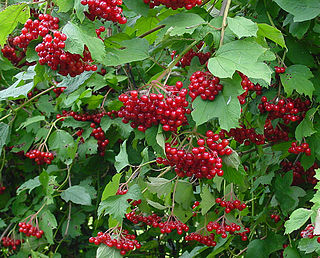
Viburnum is a genus of about 150–175 species of flowering plants in the moschatel family Adoxaceae. Its current classification is based on molecular phylogeny. It was previously included in the honeysuckle family Caprifoliaceae.
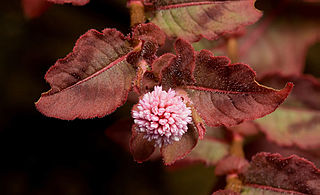
Persicaria is a genus of herbaceous flowering plants in the knotweed family, Polygonaceae. Plants of the genus are known commonly as knotweeds or smartweeds. It has a cosmopolitan distribution, with species occurring nearly worldwide. The genus was segregated from Polygonum.

Osbeckia is a genus of plants in the family Melastomataceae. It was named by Carl Linnaeus for the Swedish explorer and naturalist Pehr Osbeck (1723–1805).

Bhesa is a small genus of woody plants in the family Centroplacaceae. Its natural distribution is from southern China to New Guinea. It was formerly classified in Celastraceae, until a molecular phylogenetic study placed it in the family Centroplacaceae in the order Malpighiales.

Scleropyrum is a genus of trees in family Santalaceae first described as a genus in 1838. At present, only one species is recognized, although several others are listed as "unresolved," meaning that further research is needed to determine affinities.
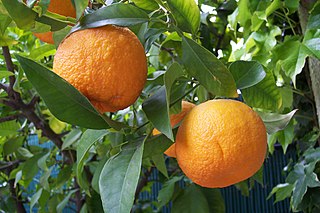
Citreae is one of the two tribes of the flowering plant family Rutaceae, subfamily Aurantioideae, the other being Clauseneae.
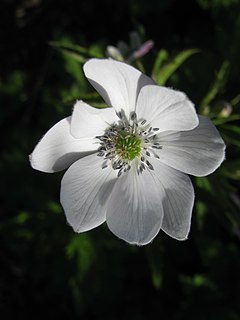
Eriocapitella rivularis, a species of flowering plant in the buttercup family Ranunculaceae, is native to Asia. The specific epithet rivularis means "waterside, of the rivers", which evidently refers to one of its preferred habitats. It is commonly called the riverside windflower. In Chinese, it is called cao yu mei, which means "grass jade plum".
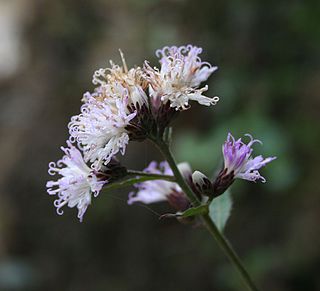
Acilepis is a genus of Asian plants in the Vernonieae within the daisy family.
Dobinea is a small genus of plants in the subfamily Anacardioideae of the cashew and sumac family Anacardiaceae. The species are dioecious and grow as shrubs or perennial herbs. They grow naturally in the East Himalaya region and China.
Persicaria posumbu is a species of flowering plant in the family Polygonaceae. It was first described as Polygonum posumbu in 1825 and transferred to the genus Persicaria in 1919. Plants of the World Online records it as having a discontinuous native distribution: the Assam region, Bangladesh and the eastern Himalayas to the west, and Japan, Korea, the Kuril Islands and Primorye to the east.

Hypericum patulum, known as goldencup St. John's wort or yellow mosqueta, is a species of flowering plant in Hypericumsect. Ascyreia.
Ficus triloba is an Asian species of fig tree in the family Moraceae. It is dioecious, with male and female flowers produced on separate individuals.

Persicaria runcinata is a species of flowering plant in the family Polygonaceae, native to the eastern Himalayas and Myanmar. It was first described in 1825 as Polygonum runcinata.

Isodon lophanthoides is a species of plant in the family Lamiaceae native from the Indian subcontinent to China.

Eriocapitella is a genus of flowering plants in the buttercup family Ranunculaceae. Plants of the genus are native to Asia. The generic name Eriocapitella roughly translates to "growing in a small woolly head", which refers to the hairy ovary and fruit of some members of the genus. Cultivated plants are commonly known as fall-blooming anemones.
Eriocapitella vitifolia, a species of flowering plant in the buttercup family Ranunculaceae, is native to Asia. The specific epithet vitifolia means "vine-leaved, with leaves resembling those of Vitis", the genus of grapevines, and so the plant is commonly called the grape-leaved anemone or grape-leaved windflower. In Chinese, a common name is ye mian hua, which means "wild cotton".
Dopatrium is a genus of flowering plants belonging to the family Plantaginaceae.
Pauldopia is a genus of flowering plants belonging to the family Bignoniaceae.
Sopubia is a genus of flowering plants belonging to the family Orobanchaceae.












